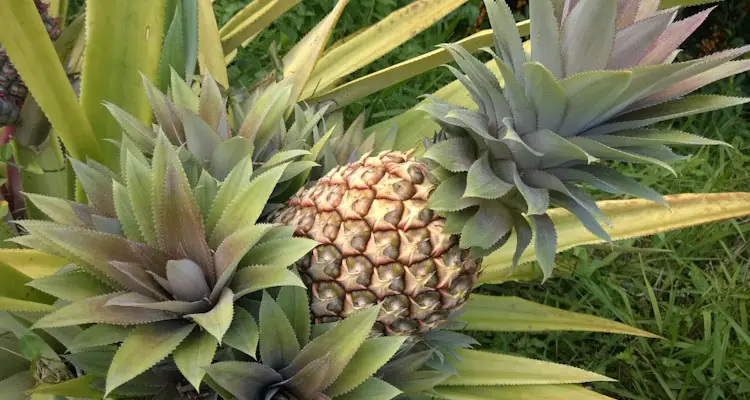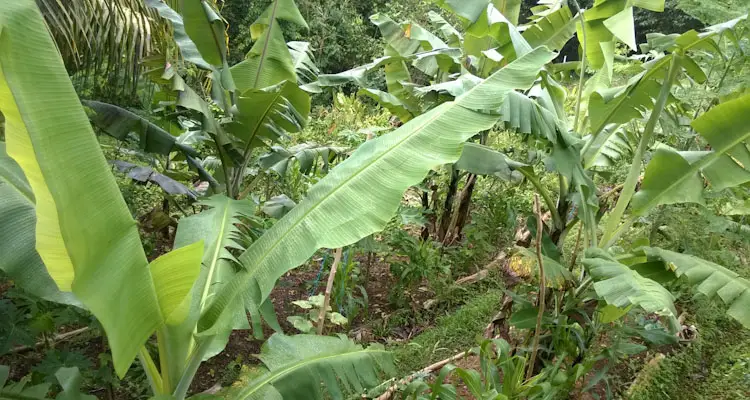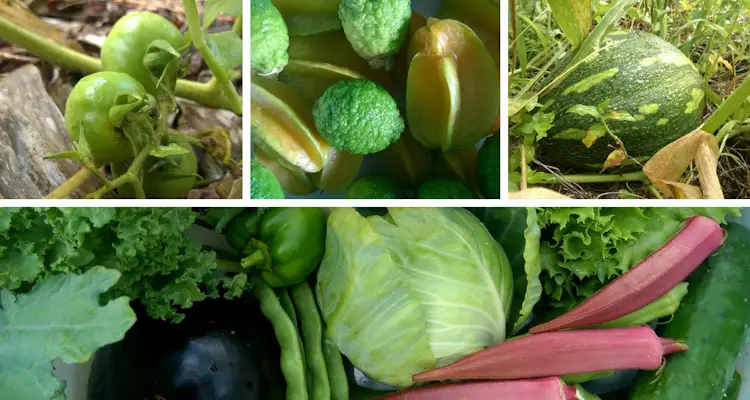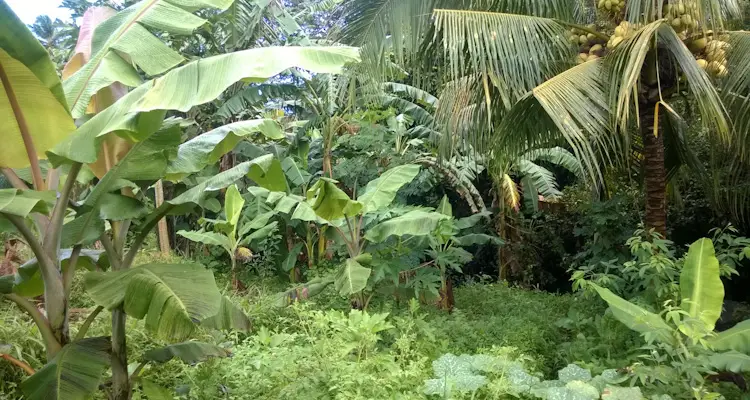Syntropic Agroforestry is a food production system that attempts to mimic the look and function of a natural forest. It uses a combination of simple techniques to move the system through various stages of natural succession.
Initially, I was captivated by the simplicity of the Syntropic Farming system and overlooked some critical details. This resulted in unrealistic expectations and several failed crops.
Thankfully, with additional research, we resolved some of the issues. The syntropic food forest made significant improvements within a short time.
This article will explore 7 things you need to know about Syntropic Agroforestry before trying to set up a system of your own. I hope this will help you avoid some of the pitfalls we encountered, saving you time, money, and energy.
Let’s get started.
1. How Does Syntropic Agroforestry Work?
In theory, Syntropic Agroforestry creates a favorable soil environment for plants to transact with microorganisms, exchanging sugars for nutrients via their roots. You can further enhance the process through mulching, synchronized pruning, and stratification.

- Mulching provides ideal habitat for the microbes while ensuring adequate food supply when needed.
- Synchronized Pruning encourages vegetative growth and stimulates microorganisms in the soil to supply the necessary nutrients, giving the entire system a boost in development.
- While Stratification ensures that all plants receive adequate sunlight while making the best use of the planting area.
In combination, these practices stimulate microbial activity, improve soil structure, and encourage the rapid growth of the entire system.
However, you will need to apply amendments such as microorganisms solutions to balance soil biology in some instances.
2. How To Plant Trees In A Syntropic Forest?
In Syntropic Agroforestry, trees are planted in rows running North to South to prevent excess shading of understory plants while maximizing the use of available space.
Unfortunately, the information available did not clarify which North; geographic or magnetic. As a result, I had issues when the sun seemed to rise in my garden’s northeast.

I later discovered that magnetic poles have been drifting eastward at a rapid pace since the 1970s. As a result, you should arrange your garden for geographical points, with the sun rising in the east and passing overhead during the day.
Ideally, plants should be planted from seeds or rhizomes, as in the case of bananas. However, in smaller systems, it is ok to use seedlings. Just ensure you take the necessary measures to protect the young plants from strong winds.
You do not need to worry about exact plant spacing as the system develops since you can always prune whenever necessary. However, please follow the plant spacing guidelines when designing the system.
3. Is Syntropic Agroforestry Profitable?
One of the main things that fascinated me about Syntropic Farming was the claim of producing a harvest in as little as three months and continuously for over 30 years. However, this early yield does not necessarily equate to immediate profit.
Syntropic Agroforestry has the potential to be profitable in the long term, based on the size of land and types of plants being produced. The cost to set up and operate a syntropic system is comparable to that of any other farming business, with similar revenue streams within the first few years.
While you will save on fertilizers and pesticides, you will need to spend more on labor and custom equipment to assist with the production of mulch and other natural soil amendments. However, once the system becomes mature, it produces more than it requires, resulting in a profit.
4. Do You Need To Use Fertilizer In Syntropic Systems?
You need to apply microbe-rich fertilizers and soil amendments into Syntropic systems within the first 2 to 3 years. Especially if you intend to get short-term yields from depleted soil.
You can also choose to do a soil biology test before attempting to supplement it. Otherwise, use relatively balanced amendments and observe the growth of the plants, increasing only if necessary.

However, avoid using synthetic fertilizers at all costs! Instead, choose natural bio-fertilizers and microorganism solutions since you aim to create a favorable environment for all involved.
Once established, the system becomes relatively self-sustainable, requiring a constant supply of organic matter obtained from the pruning of trees. At this point, the microbes will be able to extract the necessary nutrients.
5. What Are The Disadvantages Of Syntropic Agroforestry?
Ideally, Syntropic systems create microclimates, providing suitable environments for plants and microorganisms to thrive. The larger the system, the more stable the climate within.
The main disadvantage of Syntropic Agroforestry is that it requires a relatively large area to be effective. While it is possible to create a system in less than half an acre, you will have to make many compromises in terms of productivity.
This requirement also ties into the concept of economy of scale since the smaller system has similar labor requirements with less income potential, resulting in an overall loss.
We had to increase our pruning schedule in our test system, add more organic material, and plant potted plants instead of seeds. Due to limited space, these measures were necessary but resulted in additional costs.
In short, if you intend to set up a small Agroforestry system such as a Syntropic Garden, you will have to be prepared for the additional costs.
6. Is Syntropic Agroforestry Sustainable?
While the obvious answer seems to be yes, the system can fail miserably. As a result, you will need to take specific measures to ensure success.
A properly planned Syntropic Agroforestry system is sustainable in the long term, provided it is suitably sized and grows crops in demand. However, this can take years depending on the initial fertility of the soil, the chosen crops, and how much attention the system received initially.

You will need to follow specific guidelines and recommendations to ensure all your bases are covered from the onset. It can take several months before you notice issues that you had overlooked.
However, in most instances, minor issues can be quickly corrected and adjustments made to the system, allowing the system to develop and progress towards sustainability.
7. How To Start Syntropic Farming
The simplest way to get started with Syntropic Farming is to gather as much information as possible about the system and then assess whether you have the required resources.
One of the most important things to consider is whether or not you have access to enough land, organic matter, and planting material. It is also helpful to know your limits and get as much help as possible, especially when it comes to labor.
You will also have to consider your finances. While Syntropic Farming is relatively low cost if you have access to all the materials, it can be costly if you need to purchase these items.
The original Syntropic system focused on indigenous plants, resulting in a tropical food forest. While adopting this system to other climate zones might be possible, you will need additional research and experimentation.

After considering these points, it would be beneficial to get hands-on training with a practitioner of Syntropic Agroforestry. There is some training available online in guidebooks and formal online courses. However, from my experience, nothing beats hands-on training in a similar climate.
Final Thoughts
Syntropic Agroforestry is definitely safer and more sustainable than conventional systems. However, it requires ample land space and significant labor for the first few years before the real benefits become evident.
Syntropic systems are easy to set up but require knowledge and realistic expectations. Once set up, you will have to invest time and energy before receiving significant returns. As a result, you will need to be patient and enjoy the process.
Syntropic Agroforestry is not yet well known in many tropical regions despite its similarities with traditional practices. However, I am pleased to see more people have started to adopt some of the principles, albeit a bit loosely.
I expect to see more people engaging in some form of hybrid Agroforestry practices in years to come as they seek to optimize the process for commercial use.
Related Questions
Is Syntropic Agroforestry The Same Is Permaculture?
While Syntropic Agroforestry and Permaculture share similar goals, they differ in their approach to creating systems and achieving sustainability. Syntropic Agroforestry focuses on creating a long-term food and material supply. In contrast, Permaculture seeks to influence the socio-economic structure.
References
Global Freedom Project. Syntropic Farming Guidebooks. global-freedom-project.org.Accessed May 2022
Agenda Götsch. How to set up our own syntropic design apart from “recipes”? agendagotsch.com. Accessed May 2022
Adam Nz. Syntropic Agroforestry Resources. adam.nz. Accessed May 2022

